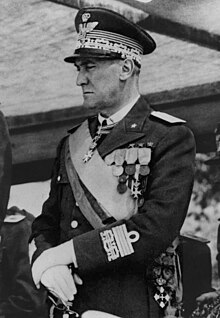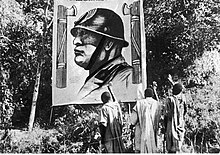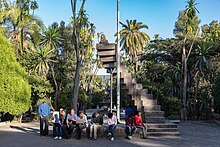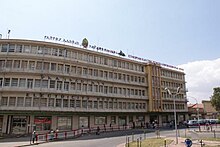Italian Ethiopia
Italian Ethiopia Etiopia italiana የኢጣልያ መንግሥት | |||||||||
|---|---|---|---|---|---|---|---|---|---|
| 1936–1941 | |||||||||
Flag | |||||||||
 Map of Italian East Africa after Italy's annexation of Ethiopia. | |||||||||
| Status | Part of Italian East Africa | ||||||||
| Capital | Addis Ababa | ||||||||
| Official languages | Italian | ||||||||
| Common languages | Amharic, Afan Oromo, Somali, Tigrinya | ||||||||
| History | |||||||||
| 9 May 1936 | |||||||||
• Declared part of Italian East Africa | 1 June 1936 | ||||||||
| 19 February 1937 | |||||||||
| 27 November 1941 | |||||||||
| Currency | Italian East African lira | ||||||||
| |||||||||
| Today part of | Ethiopia, Somalia | ||||||||
Italian Ethiopia (Italian: Etiopia italiana), also known as the Italian Empire of Ethiopia,[1] was the territory of the Ethiopian Empire, which Italy occupied for approximately five years between 1936 to 1941.[2] Italian Ethiopia was not an administrative entity, but the formal name of the former territory of the Ethiopian Empire, which now constituted the Governorates of Amhara, Harar, Galla-Sidamo, and Scioa after the establishment of Italian East Africa (Africa Orientale Italiana, AOI).[3]
After the Second Italo-Ethiopian War, in which Fascist Italy occupied Ethiopia, the Ethiopian territories were proclaimed by Benito Mussolini as part of Italian East Africa (AOI) in 1936, with the capital of the AOI being established in Addis Ababa[4] and King Victor Emmanuel III of Italy proclaiming himself Emperor of Ethiopia. Fighting between Ethiopian forces and the Italian military continued until February 1937, and subsequent guerrilla resistance against Italy persisted until 1939.[5][6]
In 1941, during World War II, Ethiopia was liberated from Italian control by Allied forces in the East African campaign, but an Italian guerrilla war continued until 1943. Ethiopia was placed under a British military administration, while Emperor Haile Selassie returned and reclaimed the Ethiopian throne. The Anglo-Ethiopian Agreement, signed in 1942, confirmed Ethiopia's status as a sovereign state, although some regions of Ethiopia were temporarily placed under British control. In December 1944, a new agreement led to the restoration of full sovereignty to Ethiopia, although the British continued to control the Ogaden until 1955.[7][8] Under the peace treaty of 1947, Italy recognized the sovereignty and independence of Ethiopia and renounced all claims to special interests or influence in that country.[9] Many Italian settlers remained for decades after receiving full pardon from Emperor Selassie.[10][11][better source needed]
Characteristics
Since 1 June 1936 Italian Ethiopia was part of the newly created Italian East Africa, and was administratively composed of four governorates: Amhara, Harar, Galla-Sidamo and Scioa. The Scioa Governorate was originally known as the Addis Abeba Governorate, but enlarged in November 1938 with parts of the neighboring governorates of Harar, Galla-Sidamo, and Amhara. Each Governorate was under the authority of an Italian governor, answerable to the Italian viceroy, who represented the Emperor Victor Emmanuel III.
Italian Ethiopia had an area of 790,000 square kilometres (305,000 sq mi) and a population of 9,450,000 inhabitants, resulting in a density of 12 inhabitants per square kilometre (31/sq mi)[12]
| Governorate | Capital | Total population | Italians[13] | Car Tag | Coat of Arms |
|---|---|---|---|---|---|
| Amhara Governorate | Gondar | 2,000,000 | 11,103 | AM | |
| Harrar Governorate | Harar | 1,600,000 | 10,035 | HA | |
| Galla-Sidamo Governorate | Jimma | 4,000,000 | 11,823 | GS | |
| Scioa Governorate | Addis Ababa | 1,850,000 | 40,698 | SC |
Some territories of the defeated Kingdom of Ethiopia were added to Italian Eritrea and Italian Somalia inside the AOI. This was not just since they were mainly populated by Eritreans and Somalis respectively, but also as a reward for their colonial soldiers who fought in the Italian Army against the Negus troops).[citation needed]
The currency used was the Italian East African lira: the Lira AOI were special banknotes of 50 lire and 100 lire circulating in AOI between 1938 [14] and 1941.
The official language was the Italian language, but in the capital region and in Tigray there was developed a koine language from Italian -according to academics like G. Bernini and L. Mori - between the native population: the Pidgin Italian of Ethiopia[15]
History
Conquest and occupation

Emperor Haile Selassie's reign was interrupted on 3 October 1935[16] when Italian forces, under the direction of dictator Benito Mussolini, invaded and occupied Ethiopia. They occupied the capital, Addis Ababa, on 5 May 1936. Emperor Haile Selassie pleaded to the League of Nations for aid in resisting the Italians. Nevertheless, the country was formally occupied on 9 May 1936 and the Emperor went into exile. The war was full of cruelty. Italian troops used mustard gas in aerial bombardments (in violation of the Geneva Conventions) against combatants and civilians in an attempt to discourage the Ethiopian people from supporting the resistance.[17][18] Deliberate Italian attacks against ambulances and hospitals of the Red Cross were reported.[19] By all estimates, hundreds of thousands of Ethiopian civilians died as a result of the Italian invasion, including during the reprisal Yekatit 12 massacre in Addis Ababa, in which as many as 30,000 civilians were killed.[20][21][22] These Italian reprisals against Ethiopian civilians have been described by some historians as constituting genocide.[23] Crimes by Ethiopian troops included the use of Dum-Dum bullets (in violation of the Hague Conventions), the killing of civilian workmen (including during the Gondrand massacre) and the mutilation of captured Eritrean Ascari and Italians (often with castration), beginning in the first weeks of war.[24][25]

Marshal Rodolfo Graziani, who replaced Marshal Badoglio as viceroy of Italian East Africa in May 1936 was short-tempered and inclined to violence and atrocities multiplied under his administration. Following a failed attack against Addis Ababa by rebels on 28 July 1936, he had the archbishop of Dessie, whom he suspected of being behind the attack shot the same afternoon. All resisting Ethiopians were declared "bandits" and he ordered that they be shot on capture. Mussolini approved the decision but requested that the order be kept secret. Following the defeat of rebels led by Ras Desta in the western part of the country in late December 1936, he had 1,600 rebel troops who surrendered summarily executed by firing squads. Villages that had been friendly to Desta were burned to the ground and women and children shot. Desta and other captured rebel leaders were executed in February 1937.
The Italians undertook many other terrorist actions during this period. Following a bloody attempt on the life of Graziani and other Italian officials by two Eritreans during a ceremony to celebrate the birth of the Prince of Naples on 19 February 1937, the police and soldiers, fearing a general uprising, fired indiscriminately into the crowd. Innocent bystanders were shot. For the next three days, the Italians, led by the Blackshirts, went on a rampage of murder and destruction throughout Addis Ababa. By the end of 1937 more than 5,000 people had been executed for alleged crimes related to the attempt against Graziani, and a total of 19,200 to 30,000 civilians were killed.[26] Among the dead were virtually all the young educated Ethiopians the Italians could lay their hands on and all the officers and cadets of the Holeta Military Academy. The Italian viceroy had hermits, soothsayers and travelling minstrels rounded up and executed. Convinced that the high clergy had known about the plot, he had many executed. In May 1937, he ordered 297 monks of the monastery of Debre Libanos and 23 other individuals suspected of complicity shot. Over 100 deacons and students were also executed. Several hundred monks were sent to concentration camps. Viceroy Graziani was finally replaced in November 1938 by the more humane Duke of Aosta, who put an end to wanton atrocities which had had the effect of increasing resistance to Italian domination.[27]

While some countries recognized the Italian conquest, Britain, France, the United States, the Soviet Union, China and the League of Nations refused to formally recognize it and consequently it remained illegitimate in international law.[a] The King of Italy (Victor Emmanuel III) was crowned Emperor of Ethiopia and the Italians created an Italian empire in Africa (Italian East Africa) with Ethiopia, Eritrea and Italian Somalia in spring 1936.
In 1937 Mussolini boasted that, with his conquest of Ethiopia, "finally Adua was avenged".
The Italians decreed miscegenation to be illegal.[28] Racial separation, including residential segregation, was enforced as thoroughly as possible and the Italians showed favouritism to non-Christian groups. To isolate the dominant Amhara rulers of Ethiopia, who supported Selassie, the Italians granted the Oromos, the Somalis and other Muslims, many of whom had supported the invasion, autonomy and rights.
There was substantial investment in Ethiopian infrastructure development, with the budget for AOI from 1936 to 1937 requiring 19,136 billion lire when the annual revenue of Italy was only 18,581 billion lire.[29]: 5 This infrastructure development was part of a plan to bring half a million Italians to colonize the Ethiopian plateaus. In October 1939 the Italian colonists in Ethiopia were 35,441, of whom 30,232 male (85.3%) and 5,209 female (14.7%), most of them living in urban areas.[30] Only 3,200 Italian farmers moved to colonize farm areas, mostly around the capital and in the Scioa Governorate, where they were under sporadic attack by pro-Haile Selassie guerrillas through 1939.
The Italians created the "Imperial Road" between Addis Ababa and Massaua, the Addis Ababa – Mogadishu and the Addis Ababa – Assab.[31] the Italians built more than 4,500 km of roads linking the country beyond 900 km of railways were reconstructed or initiated (like the railway between Addis Ababa and Assab), dams and hydroelectric plants were built, and many public and private companies were established in the underdeveloped country. The most important were: "Compagnie per il cotone d'Etiopia" (Cotton industry); "Cementerie d'Etiopia" (Cement industry); "Compagnia etiopica mineraria" (Minerals industry); "Imprese elettriche d'Etiopia" (Electricity industry); "Compagnia etiopica degli esplosivi" (Armament industry); "Trasporti automobilistici (Citao)" (Mechanic & Transport industry).

Italians also created new airports and in 1936 started the worldwide famous Linea dell'Impero, a flight connecting Addis Ababa to Rome. The line was opened after the Italian conquest of Ethiopia and was followed by the first air links with the Italian colonies in Italian East Africa, which began in a pioneering way since 1934. The route was enlarged to 6,379 km and initially joined Rome with Addis Ababa via Syracuse, Benghazi, Cairo, Wadi Halfa, Khartoum, Kassala, Asmara, Dire Dawa.[32] There was a change of aircraft in Benghazi (or sometimes in Tripoli). The route was carried out in three and a half days of daytime flight and the frequency was four flights per week in both directions. Later from Addis Ababa there were three flights a week that continued to Mogadishu, capital of Italian Somalia.
The most important railway line in the African colonies of the Kingdom of Italy, the 784 km long Franco-Ethiopian Railway, was seized following the conquest of Ethiopia in 1936. The route was served until 1935 by steam trains that took about 36 hours to do the total trip between the capital of Ethiopia and the port of Djibouti. Following the Italian conquest was obtained in 1938 the increase of speed for the trains with the introduction of four railcars high capacity "type 038" derived from the model Fiat ALn56.[33]
These diesel trains were able to reach 70 km/h and cutting time travel in half to just 18 hours: they were used until the mid-1960s.[34] At the main stations there were some bus connections to the other cities of Italian Ethiopia not served by the railway.[35] Additionally, a special fire-control unit was created near the Addis Ababa station, which was the first one in Africa.[36] Through 1938 trains carried protective military units because of ongoing Ethiopian guerrilla activity.[37]


Shifta (Ethiopian guerrillas) were still in control of nearly a quarter of the Ethiopian highlands through late 1939. By the eve of World War II they were still in control of Harar and the Galla-Sidamo Governorate. Abebe Aregai, the last leader of the "Arbegnochs" (as the guerrilla fighters were called in Ethiopia) made a surrender proposal to the Italians in spring 1940 after the 1939 surrender of Ethiopian leaders Zaudiè Asfau and Olonà Dinkel.[38] During the five years of Italian occupation, Catholicism also grew in importance, thanks mainly to the efforts of missionaries like Elisa Angela Meneguzzi. She became known as the "Ecumenical Fire" due to her strong efforts at ecumenism with Coptic Christians and Muslims while also catering to relations with the Catholics of Dire Dawa.[39]

World War II
During World War II, in the summer of 1940 Italian armed forces completed the Italian conquest of British Somaliland.[40] By the spring of 1941, the British had counter-attacked and pushed deep into Italian East Africa. By 5 May, Haile Selassie had returned to Addis Ababa to reclaim his throne. In November, the last organised Italian resistance in Ethiopia ended with the fall of Gondar.[41] Following the surrender of East Africa, some Italians conducted a guerrilla war which lasted for two more years.
This guerrilla action was done primarily by military units with Italian officers (like Captain Paolo Aloisi, Captain Leopoldo Rizzo, Blackshirt officer De Varda and Major Lucchetti) but also by civilians like Rosa Dainelli. She was a doctor who in August 1942 succeeded in entering the main ammunition depot of the British army in Addis Ababa, and blowing it up, miraculously survived the huge explosion. Her sabotage destroyed the ammunition for the new British Sten sub machine gun, delaying the use of this "state of the art" armament for many months.[42] Her true name was Danielli Rosa and the date of attack was 15 September 1941.[43]
After World War II

The recognition by the United Kingdom of the full sovereignty of Ethiopia occurred with the signing on 19 December 1944 of the Anglo-Ethiopian agreement which acknowledged Ethiopia to be "a free and independent state"[44] although the Ogaden continued to remain under British control until 1955.[8]
In the peace treaty of February 1947, Italy renounced sovereignty over its African colonies of Libya, Eritrea and Somalia (art. 23) and recognised the independence of Ethiopia (art. 33), by then a sovereign member of the United Nations.
Italy further agreed to:
- Pay War reparation of US$25,000,000 to Ethiopia
- Accept "Annex XI of the Treaty", upon the recommendation of the United Nations General Assembly in Resolution 390, that indicated that Eritrea was to be federated with Ethiopia.
After the war, the Italian Ethiopians were given a full pardon by the newly returned Emperor Haile Selassie, as he saw the opportunity to continue the modernization efforts of the country.[45] He declared that no reprisals would be taken against the Italians, and many remained for decades, until the overthrow of the Emperor in the Ethiopian Civil War in 1974. Nearly 22,000 Italo-Ethiopians took refuge in Italy during the 1970s.[45] Their main organization in Italy is the Associazione Italiana Profughi dall'Etiopia ed Eritrea (A.I.P.E.E.).[46]
In recent years, some Italian companies have returned to operate in Ethiopia, and a large number of Italian technicians and managers arrived with their families, residing mainly in the metropolitan area of the capital.[47]
Contemporary relations
In the mid-1990s, a populist movement made up of Italians and Ethiopians (both in country and expatriates around the world) began to petition the then-current Italian government to return the obelisk,[48] an event which eventually culminated in its repatriation in 2008 to Axum, the city of its creation.[49]
The Italian firm Salini Costruttori was chosen by the Ethiopian government to design and build the Millennium or Renaissance Dam on the Blue Nile river, which when completed will be the largest dam and hydroelectric plant in Africa.[50] As the Italian engineers had helped to build the first railway from Addis Ababa to Djibouti in the past, the Ethiopian government has contracted them again to expand the railroad network along with India and China.[51] For the last 20 years, Italy has continued to be among the top 5 trading partners with Ethiopia and a major investor in the Ethiopian economy.[52]
Ethiopian languages such as Amharic and Tigrinya have many words borrowed from the Italian language, for example "gettone" (token), "bigli" from Italian "biglie" (glass marbles), "borsa" (bag), "machìna" from Italian "macchina" (car), "carburatore" (carburetor) and others.[53][54][55] Ethiopia has Italian schools and cultural institutes (such as the Scuola Statale Italiana of Addis Ababa), which foster and promote Italian and Ethiopian culture and are free to the public.[56]
Banknotes and postage stamps
On 5 May 1936 the capital Addis Ababa was captured by the Italians: on 22 May three new stamps showing the King of Italy were issued. Four further values inscribed "ETIOPIA" were issued on 5 December 1936. After that date, the stamps were issued with the name "Africa Orientale Italiana" on it.[57][citation needed]
See also
- Italian East Africa topics
- Italians of Ethiopia
- Italian Eritrea
- Italian Somalia
- Linea dell'Impero
- Prince Amedeo, Duke of Aosta
- Italian-built roads in Ethiopia
- Pidgin Italian of Ethiopia
Notes
- ^ For that reason, following the collapse of Italian power in 1941, Haile Selassie reassumed power without the need of any formal recognition by the international community.
Footnotes
- ^ "Fascismo: guerra d'Etiopia". www.storiaxxisecolo.it.
- ^ Pasquale Villani, L'età contemporanea (Italian), il Mulino, Bologna, 1983, 1993, ISBN 88-15-02704-1, p. 446.
- ^ Conte, Alessio (8 January 2017). "Nasce l'Impero: l'Etiopia italiana".
- ^ "Dadfeatured: ITALIAN ADDIS ABEBA". 11 December 2018.
- ^ Anthony, Mockler (2003). Haile Selassie's War. New York: Olive Branch Press. pp. 172–173. ISBN 978-1-56656-473-1.
- ^ Barker 1968, p. 281, 300.
- ^ Shinn, David H.; Ofcansky, Thomas P. (11 April 2013). Historical Dictionary of Ethiopia. Scarecrow Press. pp. 309–. ISBN 978-0-8108-7457-2.
- ^ a b Clapham,"Ḫaylä Ś�llase", Encyclopaedia Aethiopica, p. 1063.
- ^ "Treaty of Peace with Italy" (PDF). Library of Congress.
- ^ cfr. Angelo del Boca, op cit., p. 201
- ^ "Hailè Selassiè - Amare ODV Onlus". www.amareonlus.com.
- ^ Royal Institute of International Affairs (24 August 1940). "Italian Possessions in Africa: II. Italian East Africa". Bulletin of International News. 17 (17): 1065–1074. JSTOR 25642850.
- ^ Istat Statistiche 2010
- ^ "Bank of Italy". Archived from the original on 27 March 2012. Retrieved 27 January 2020.
- ^ Mori/Mury. Addis Ababa Pidgin Italian.“Appendice. Repertorio delle lingue pidgin e creole per aree geografiche”, in Turchetta (a cura di), p. 223-251
- ^ Barker, A. J. (1971). Rape of Ethiopia, 1936. New York: Ballantine Books. p. 33. ISBN 978-0-345-02462-6.
- ^ Belladonna, Simone (20 April 2015). Gas in Etiopia: I crimini rimossi dell'Italia coloniale (in Italian). Neri Pozza Editore. ISBN 9788854510739.
- ^ Mack Smith, Denis (1983) [1981]. Mussolini. London: Granada. pp. 231, 417. ISBN 0-586-08444-4. OCLC 12481387.
- ^ Rainer Baudendistel, Between bombs and good intentions: the Red Cross and the Italo-Ethiopian War, 1935–1936. Berghahn Books. 2006 pp. 239, 131–2 [1]
- ^ Campbell, Ian (2017). The Addis Ababa Massacre: Italy's National Shame. London. ISBN 978-1-84904-692-3. OCLC 999629248.
{{cite book}}: CS1 maint: location missing publisher (link) - ^ Barker 1968, pp. 292–293.
- ^ Martel, Gordon (1999). The origins of the Second World War reconsidered : A.J.P. Taylor and the Historians (2nd ed.). London: Routledge. pp. 188. ISBN 0-203-01024-8. OCLC 252806536.
- ^ Labanca, Nicola (2004). "Colonial rule, colonial repression and war crimes in the Italian colonies". Journal of Modern Italian Studies. 9 (3): 300–313. doi:10.1080/1354571042000254737. S2CID 144498755.
- ^ Sbacchi 1979, p. 43.
- ^ Antonicelli 1975, p. 79.
- ^ Campbell 2017.
- ^ Paul B. Henze, Layers of Time. A History of Ethiopia, Palgrave, New York, 2000, p. 225–227.
- ^ Barrera, Giulia (2003). "Mussolini's colonial race laws and state-settler relations in Africa Orientale Italiana (1935-41)". Journal of Modern Italian Studies. 8 (3): 425–443. doi:10.1080/09585170320000113770. S2CID 145516332.
- ^ Cannistraro, Philip V. (1982). Historical Dictionary of Fascist Italy. Westport, Connecticut: Greenwood Press. ISBN 978-0-313-21317-5.
- ^ "Italian emigration in Etiopia (in Italian)" (PDF).
- ^ "Article on the special road Addis Abeba-Assab and map (in Italian)" (PDF). 1940. Archived from the original (PDF) on 29 March 2016. Retrieved 28 September 2019.
- ^ "AFRICA in "Enciclopedia Italiana"". www.treccani.it.
- ^ "LE CHEMIN DE FER FRANCO ETHIOPIEN ET DJIBOUTO ETHIOPIEN". www.train-franco-ethiopien.com. Archived from the original on 24 February 2021. Retrieved 17 February 2018.
- ^ "LE CHEMIN DE FER FRANCO ETHIOPIEN ET DJIBOUTO ETHIOPIEN". www.train-franco-ethiopien.com.
- ^ "LE CHEMIN DE FER FRANCO ETHIOPIEN ET DJIBOUTO ETHIOPIEN". www.train-franco-ethiopien.com.
- ^ ""Pompieri ad Addis Abeba" (in Italian)". Archived from the original on 4 November 2016. Retrieved 9 January 2015.
- ^ "LE CHEMIN DE FER FRANCO ETHIOPIEN ET DJIBOUTO ETHIOPIEN". www.train-franco-ethiopien.com.
- ^ Bahru Zewde, "A History of Modern Ethiopia", second edition (Oxford: James Currey, 2001), pp. 172f
- ^ "Blessed Liduina Meneguzzi". 25 November 2008.
- ^ Dickson 2001, p. 103.
- ^ Jowett 2001, p. 7.
- ^ Rosselli, Alberto. Storie Segrete. Operazioni sconosciute o dimenticate della seconda guerra mondiale. pag. 103
- ^ Di Lalla, Fabrizio, “Sotto due bandiere. Lotta di liberazione etiopica e resistenza italiana in Africa Orientale”. p. 235
- ^ Henze, p. 235.
- ^ a b "Fratelli d'Etiopia". 29 April 2008. Archived from the original on 11 February 2017.
- ^ "Associazione Italiana Profughi dall'Etiopia ed Eritrea (AIPEE)". Archived from the original on 3 March 2016. Retrieved 12 January 2019.
- ^ "I servizi demografici". Dipartimento per gli affari interni e territoriali. 25 November 2016.
- ^ "Ethiopia Again Demands Italy Return Obelisk". Chicago Tribune. 10 March 2002. Archived from the original on 2 April 2015. Retrieved 18 January 2019.
- ^ "Obelisk returned to Ethiopia after 68 years". TheGuardian.com. 20 April 2005. Archived from the original on 8 August 2022. Retrieved 21 December 2022.
- ^ "webuild". www.webuildgroup.com.
- ^ "posh100! Review Reviews, Home Improvement, Tools..." posh100! Review. Archived from the original on 25 May 2021. Retrieved 30 May 2021.
- ^ "MIT Country Profile – Ethiopia: Trading Partners".
- ^ Beyene, Yaqob (2011). "I prestiti italiani in amarico e tigrino". jstor.org.
- ^ Hoffmann, Saul (2013). "Il lascito linguistico italiano in Dodecaneso, Libia e Corno d'Africa: L2, pidgin e prestiti (Università degli Studi di Pavia, Dipartimento di scienze umane)" (PDF). core.ac.uk.
- ^ Banti, Giorgio (2008). "Italianismi lessicali in saho". researchgate.net.
- ^ "Come raggiungerci". iicaddisabeba.esteri.it.
- ^ "Italian Stamps - Ethiopia". www.italianstamps.co.uk.
Bibliography
- Antonicelli, Franco (1975). Trent'anni di storia italiana: dall'antifascismo alla Resistenza (1915–1945) lezioni con testimonianze [Thirty Years of Italian History: From Antifascism to the Resistance (1915–1945) Lessons with Testimonials]. Reprints Einaudi (in Italian). Torino: Giulio Einaudi Editore. OCLC 878595757.
- Bandini, Franco (1971). Gli italiani in Africa: Storia delle guerre coloniali 1882–1943 (in Italian). Milan, Italy: Longanesi. OCLC 1253348.
- Barker, A. J. (1968). The Civilising Mission: The Italo-Ethiopian War 1935–6. London: Cassell. ISBN 978-0-304-93201-6.
- Beltrami, Vanni (2013). Italia d'Oltremare: Storie dei territori italiani dalla conquista alla caduta (in Italian). Rome Italy: Edizioni Nuova Cultura. p. 273. ISBN 978-88-6134-702-1. Retrieved 20 December 2017.
- Dickson, Keith (2001). World War II for Dummies. Hoboken, New Jersey: Wiley. ISBN 978-0-7645-5352-3.
- Inventario dell'Archivio Storico del Ministero Africa Italiana [Index of the historical archive of the ministry of Italian Africa (1857–1939)] (PDF) (in Italian), vol. I, Rome, Italy: Ministry of Foreign Affairs (Italy), 1975, retrieved 20 December 2017
- Jowett, Philip S. (2001). The Italian Army 1940–45 (Africa 1940–43). Vol. II. Oxford: Osprey. ISBN 978-1-85532-865-5.
- Sbacchi, Alberto (April 1979). "Hailé Selassié and the Italians, 1941–43". African Studies Review. XXII (1). African Studies Association.









